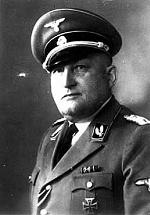
77th SS-Standarte
Encyclopedia

Germany
Germany , officially the Federal Republic of Germany , is a federal parliamentary republic in Europe. The country consists of 16 states while the capital and largest city is Berlin. Germany covers an area of 357,021 km2 and has a largely temperate seasonal climate...
(now Poland
Poland
Poland , officially the Republic of Poland , is a country in Central Europe bordered by Germany to the west; the Czech Republic and Slovakia to the south; Ukraine, Belarus and Lithuania to the east; and the Baltic Sea and Kaliningrad Oblast, a Russian exclave, to the north...
). The Standarte was established in 1934, one year after Adolf Hitler
Adolf Hitler
Adolf Hitler was an Austrian-born German politician and the leader of the National Socialist German Workers Party , commonly referred to as the Nazi Party). He was Chancellor of Germany from 1933 to 1945, and head of state from 1934 to 1945...
and the Nazi Party assumed power, and by 1935 was at full complement.
One notable member of the Standarte was Richard Glücks
Richard Glücks
Richard Glücks was a high-ranking Nazi official. He attained the rank of a SS-Gruppenführer and a Generalleutnant of the Waffen-SS and from 1939 until the end of World War II was the head of Amt D: Konzentrationslagerwesen of the WVHA; the highest-ranking Concentration Camps Inspector in Nazi...
who assumed command of the unit in 1935. Glücks would later rise to command Germany's concentration camp network as head of the SS-Totenkopfverbände
SS-Totenkopfverbände
SS-Totenkopfverbände , meaning "Death's-Head Units", was the SS organization responsible for administering the Nazi concentration camps for the Third Reich....
.
In the late 1930s, the 77th Standarte mainly engaged in mustering drill formations and parades. At the start of World War II
World War II
World War II, or the Second World War , was a global conflict lasting from 1939 to 1945, involving most of the world's nations—including all of the great powers—eventually forming two opposing military alliances: the Allies and the Axis...
, most of the Standarte members were called up to serve in the regular Germany military (Wehrmacht
Wehrmacht
The Wehrmacht – from , to defend and , the might/power) were the unified armed forces of Nazi Germany from 1935 to 1945. It consisted of the Heer , the Kriegsmarine and the Luftwaffe .-Origin and use of the term:...
) since the mustering formations were not exempt from conscription
Conscription
Conscription is the compulsory enlistment of people in some sort of national service, most often military service. Conscription dates back to antiquity and continues in some countries to the present day under various names...
. The unit continued to actively operate until 1943 at which time the regiment had lost nearly all of its members and war-time activities in eastern Germany superseded the need for part time musters and Nazi parades.
The last commander of the 77th SS-Standarate, SS-Obersturmbannführer
Obersturmbannführer
Obersturmbannführer was a paramilitary Nazi Party rank used by both the SA and the SS. It was created in May 1933 to fill the need for an additional field grade officer rank above Sturmbannführer as the SA expanded. It became an SS rank at the same time...
Paul Becker, was detached on July 1, 1943 and from this point on the unit existed only on paper. The Standarte was formally disbanded in May of 1945 with the defeat of Nazi Germany
Nazi Germany
Nazi Germany , also known as the Third Reich , but officially called German Reich from 1933 to 1943 and Greater German Reich from 26 June 1943 onward, is the name commonly used to refer to the state of Germany from 1933 to 1945, when it was a totalitarian dictatorship ruled by...
.
Commanders
- SS-UntersturmführerUntersturmführerUntersturmführer was a paramilitary rank of the German Schutzstaffel first created in July 1934. The rank can trace its origins to the older SA rank of Sturmführer which had existed since the founding of the SA in 1921...
Hans-Georg Neumann (January 26, 1934 - May 3, 1934) - SS-ObersturmführerObersturmführerObersturmführer was a paramilitary rank of the Nazi party that was used by the SS and also as a rank of the SA. Translated as “Senior Assault Leader”, the rank of Obersturmführer was first created in 1932 as the result of an expansion of the Sturmabteilung and the need for an additional rank in...
Georg Schmidt (May 3, 1934 - June 6, 1934) - SS-HauptsturmführerHauptsturmführerHauptsturmführer was a Nazi rank of the SS which was used between the years of 1934 and 1945. The rank of Hauptsturmführer was a mid-grade company level officer and was the equivalent of a Captain in the German Army and also the equivalent of captain in foreign armies...
Horst Felchner (June 6, 1943 - June 20, 1935) - SS-Obersturmbannführer Richard Glücks (June 20, 1935 - April 1, 1936)
- SS-StandartenführerStandartenführerStandartenführer was a Nazi Party paramilitary rank that was used in the so-called Nazi combat-organisations: SA, SS, NSKK and the NSFK...
Simon Füss (April 1, 1936 - March 21, 1938) - SS-Obersturmbannführer Ewald Strohm (March 21, 1938 - March 1, 1939)
- SS-Standartenführer Wilhelm Hiller (March 1, 1939 - July 1, 1939)
- SS-Obersturmbannführer Paul Becker (July 1, 1939 - July 1, 1943)
Reference
- Yerger, Mark C. Allgemeine-SS: The Commands, Units, and Leaders of the General SS, Schiffer Publishing (1997). ISBN 0-7643-0145-4

